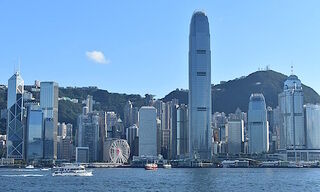Is China In Crisis?
In his latest Ahead of the Curve, Neil Williams, Group Chief Economist at Hermes Investment Management, assesses the macroeconomic outlook in China.
Despite China’s slowdown, global growth should not be completely derailed. But, it is a headwind, with the pressure to preserve world growth now tilting back from the emerging to advanced economies.
After 3.4% yoy world growth in 2014, the IMF now expects 3.1% in 2015, and only a shallow uplift to 3.8% yoy by 2017. If it is right, this 3.1% stands to be the lowest since 2009, when China was officially growing 9% yoy. At about 2% yoy, the gap this year between the advanced and emerging economies’ growth rates is likely to be the smallest since the dot.com boom in 2000.
China is slowing from a high peak and can soften the landing...
Yet, China’s slowdown - even to a more realistic 3% growth scenario - starts from a very high base. This is relative to both the G7, and other BRIC economies.
Admittedly risks remain. If the usual lags hold, the deceleration in money-growth engineered by The People’s Bank of China (PBoC) after 2010 suggests another nine months before China’s ‘coincident indicator’ (used to detect turning points) picks up.
Alternative measures suggest official growth is overstated. Suspicion understandably falls on China’s speedy compilation of GDP data: the G8’s fastest. Released within three weeks of the pertaining quarter, they are barely revised, and consistently close to target. For 2015, the target is “close to 7%”, with Premier Li inferring a minimum +6.5% per annum needed to 2020.
Alternative measures suggest a dislocation since 2012 from the official growth target to a ‘true’ rate closer to 3% yoy.
And two unknowns are now the extent to which leverage behind China’s equity positions dents activity, possibly via real estate; and the deflationary flow - via falling commodity prices, lower Asian exchange rates, and cheaper exports – to the G7.
China has an array of policy ‘buttons’ to press. But it must act...
While wary of the risks, we take comfort that China still has an array of policy ‘buttons’ to press to soften the landing. But, it needs to act.
First, on the monetary front, real lending rates of 4% and 15.5%-18% reserve requirement ratios (RRR) for banks are still punitive, and can be cut more aggressively. When taken in tandem, such as in 2010-12, these changes do impact China’s activity.
Second, with August-September’s $137bn reserve outflow clearly unsustainable, further renminbi devaluations will be used as a pressure release. Non-deliverable forwards suggest only -5.5% over two years, which looks modest. Further intervention would raise questions about China’s commitment to US Treasuries. So, a one-off devaluation may be preferable to a constant ‘drip-feed’.
Then there’s fiscal policy. With the 2014 budget deficit officially reported at just 1.8% of GDP (which would make it the G8’s third lowest), there’s ample scope for largesse. Expect more stimuli ranging from agricultural subsidies and infrastructure spending (each traditionally used to hit growth targets), direct lending to preferred sectors such as agriculture and SMEs, and ad hoc liquidity injections.
And, should domestic debt strains build, China could run QE. Admittedly more troublesome might be dealing with what could be up to $1trn of corporate and bank foreign-currency debt. Isolated defaults are possible – but the PBoC would surely delve into its still massive $ 3½trn foreign exchange reserves to avoid something more systemic.
Handing over the growth baton...
For some, the ‘triple whammy’ of China devaluation, US rate hike, and European weakness will revive memories of 1994 when most assets were hit hard. But that was a different time. China’s devaluation was huge, based more on reform than growth, and pressured Asian sovereigns to whittle away reserves to protect their own currency pegs.
The only meaningful peg now is Hong Kong’s, which should benefit from a weaker renminbi, given half its imports are from the Mainland.
Meanwhile, the baton looks like it’s being handed back to the advanced economies to fuel world growth. This means accelerating QE in Japan, the euro-zone and Sweden, rate cuts in others (e.g. Australia, New Zealand, Norway) and competitive currency falls, while China enacts an avalanche of stimulus measures sufficient to arrest the decline and avert market turmoil.
If it doesn’t, the Fed’s rate tightening cycle could prove to be one of the shortest yet.





















